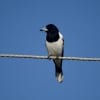 By Jim Stevenson
By Jim Stevenson
These are songbirds larger than sparrows and warblers, from the depths of Australia’s Eastern Seaboard. All is well here, and my people have seen around 200 new species. I also took them to a place the other night and we saw platypus swimming below us in the creek. No snakes except a 10-foot python I caught. The calendars are finished and they are the best ever! We’ve added some new stuff and Barbara did a fantastic job, as always.
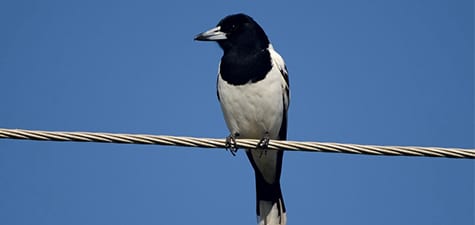
This butcherbird is one of many Australian birds with the adjective “pied” in its proper
name. That designation means “black and white,” and the Pied Butcherbird is just that.
The hook on the end of the beak may remind you of another bird with a vernacular name
of “butcherbird,” the Loggerhead Shrike. They can both kill very effectively w/ that tool.
Another term referring to black and white is “magpie.”
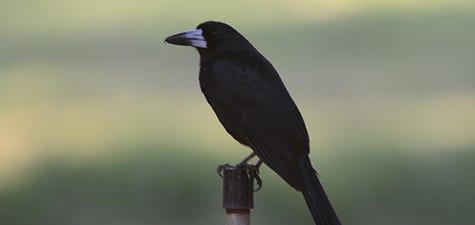
Here is another species, the Black Butcherbird.
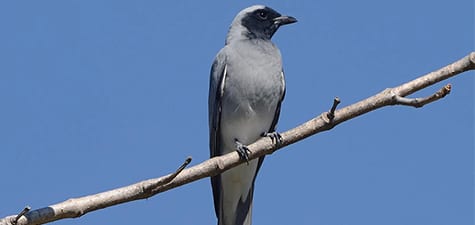
The Black-faced Cuckoo-shrike is a double compound name, not uncommon in Australia.
This species is also quite polymorphic, with several variations to this look. Names like
cuckoo-shrike came from the white settlers trying to pigeonhole Australian birds into the
same taxa they knew in Europe, instead of recognizing them as new groups entirely.
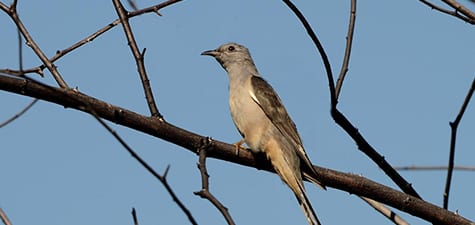
The Brush Cuckoo is one of several brood parasites in Australia, laying eggs in cupshaped
nests of warblers, etc., in the spring (October). Many arrive from further north in
their spring but others are residents in northern Australia, where it doesn’t get cold in
winter. However, being closer to the Equator, their migration isn’t as obvious as ours.
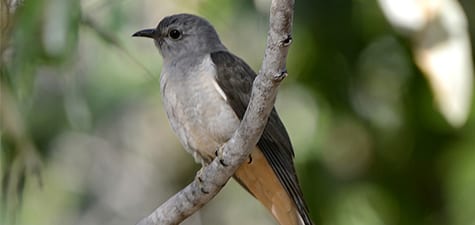
Another Brush Cuckoo, showing the variation it and others are famous for. As for nest
parasitism, it really isn’t such a problem as their numbers are fairly stable. With cowbirds
in the New World, the problem began with agr iculture, as the numbers of cowbirds went
way up and nest parasitism became epidemic. New World cuckoos like Yellow-billed do
not parasitize other species’ nests.
![The Fan-tailed Cuckoo parasitizes smaller birds such as warblers and wrens, and is one of the famous examples of baby birds quickly outgrowing their parents. [I’m sure you moms out there with six-feet-plus sons understand.] Their tail makes them a dead giveaway, like in a will. This species stays fairly close to the ground, for whatever reason???](https://www.crystalbeachlocalnews.com/wp-content/uploads/2014/07/Medium-sized-Songbirds-6.jpg)
The Fan-tailed Cuckoo parasitizes smaller birds such as warblers and wrens, and is one of
the famous examples of baby birds quickly outgrowing their parents. [I’m sure you moms
out there with six-feet-plus sons understand.] Their tail makes them a dead giveaway, like
in a will. This species stays fairly close to the ground, for whatever reason???
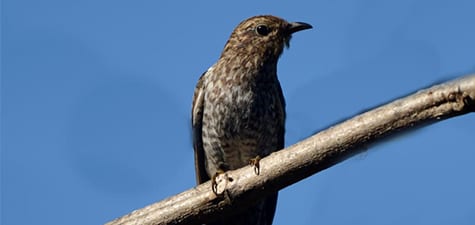
Juvenile birds of many groups are brownish w/ bars, streaks or whatever. This Fan-tailed
Cuckoo is a first-year bird and only the shape resembles the adult bird on the previous
page. They don’t need their nice colors because they don’t court, and don’t really have
the equipment to mate. Besides, kids shouldn’t do that.
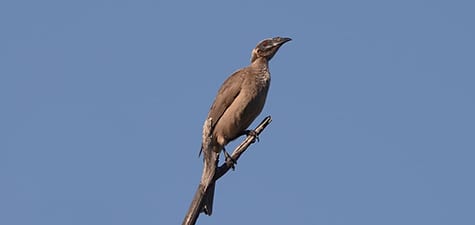
Four species of Friarbirds inhabit Australia and not a one has won a beauty contest yet.
The bare heads allow them to feed inside fruit and their loud calls may be heard for quite
some distance. Like orioles and tanagers (etc.) they eat mostly fruit but must feed bugs to
their chicks for the protein.
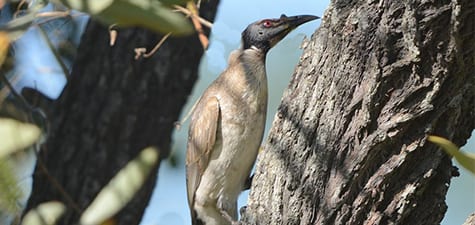
Noisy Friarbirds are just that, and sport a small knob on the bill, though smaller than
some other friarbirds. Their red eyes help them to see in low light, and possibly give them
some extra frightening power (as some have suggested). All I can say is, after looking at
their colors and head, they must have something attractive or the group would go extinct.
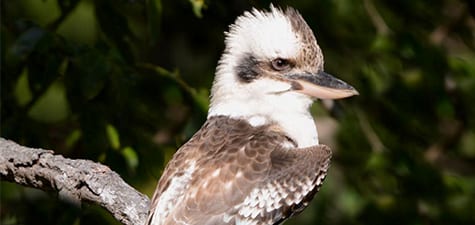
A handsome devil, the Laughing Kookaburra sits on any old tree it chooses, and is a bit
more than merry to many smaller animals they invite for lunch. The bill is more than a
match for the Aussie poisonous snakes and other birds leave them alone. There may be
nothing more comical in the bird world than two of these chattering.
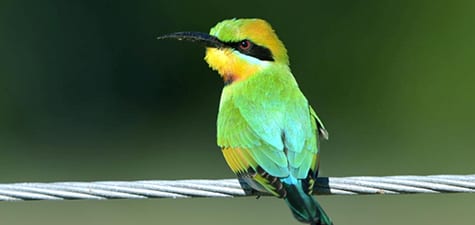
Bee-eaters are mostly found in Africa but the Rainbow Bee-eater is common over much
of the Australian Continent. They not only grab stinging bees with their long bill, they
beat them on limbs before swallowing them. In the interest of full disclosure, I was told
Aussie bees have no stingers, but I’m not hive-grabbin’ yet.
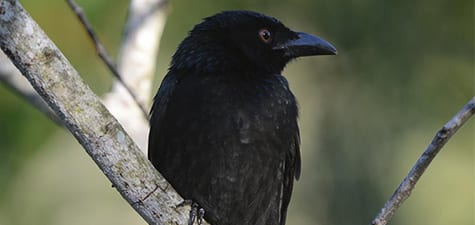
Rather unrelated to other birds, drongos are fast as greased lightning and snarf up flying
insects with alacrity and skill. Like many excellent fliers, they are tame and afford us bird
photographers easy pickings. They will often sit in the shade and dart out to grab an
unsuspecting insect before it can react.
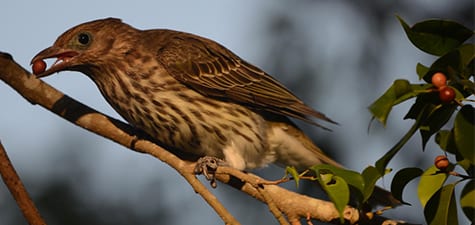
A relative of orioles, Figbirds are as frugivorous as they come. Often, trees almost sag
with this species, as the next page will show. This is a female, but the males (especially)
are polymorphic. For whatever reason, Australia has more variation in its birds than most
places, and when I was learning the birds, it added an extra stumbling block.
Below is a tree with fifteen Figbirds, only three of which are males.
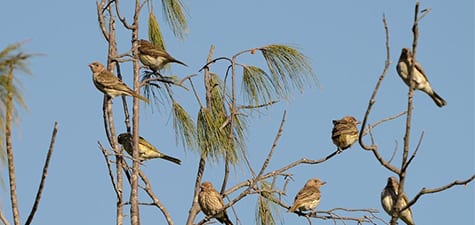
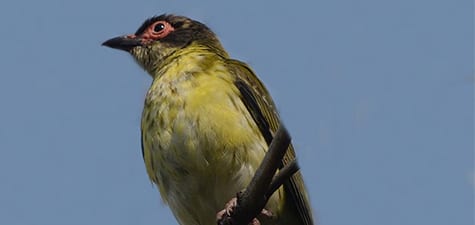
One of the things that confuse bird watchers with field identification is birds seen in their
transitional plumage. This is a young male Figbird still carrying a hint of the stripes they
had as juveniles (like females). Soon he will lose his stripes and become the attractive
bird seen just below the center of the tree you just looked at.
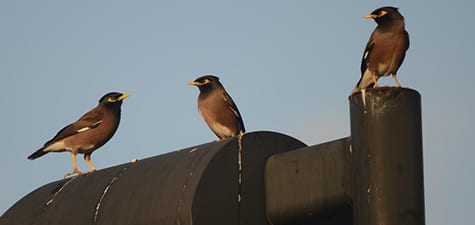
Common Myna are founds in many residential areas of Australia, although government
officials are trying to eradicate them (such as in Cairns). This species originated in the
European continent but has been introduced in many areas around the World, such as
South Florida, which has many infidels, like UM.

 Posted in
Posted in 
























